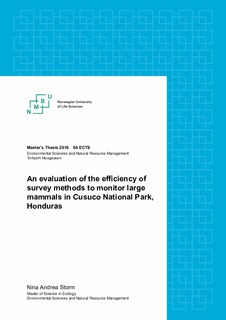| dc.contributor.advisor | Haugaasen, Torbjørn | |
| dc.contributor.advisor | Bischof, Richard | |
| dc.contributor.author | Storm, Nina Andrea | |
| dc.coverage.spatial | Honduras | nb_NO |
| dc.date.accessioned | 2018-09-30T12:08:59Z | |
| dc.date.available | 2018-09-30T12:08:59Z | |
| dc.date.issued | 2017 | |
| dc.identifier.uri | http://hdl.handle.net/11250/2565307 | |
| dc.description.abstract | Field sign surveys and camera trap surveys are frequently used in the tropics as the preferred survey technique to monitor large terrestrial mammal communities. However, these methods vary in the efficiency of detecting certain species. Investigating these variations are important to improve survey efforts, survey design and efficiency of detecting focal species. Cusuco National Park is part of the Mesoamerican hotspot, inhabiting a large mammal community important for ecosystem functions. The study mainly aimed to investigate variation in species detection probabilities according to survey method. The study also aimed to get an understanding of the large mammal composition in the park. Finally, this study aimed to examine the temporal variation in species detection probabilities for field sign surveys. Field sign surveys and camera trap surveys have been undertaken annually in the park since 2014. Field sign surveys proved as the most effective method for surveying Baird’s tapir, Central American agouti, nine-banded armadillo, white-nosed coati and grey fox. For spotted paca, small felid sp. and tayra, camera trap surveys proved to be the most effective method. None of the methods proved more effective than the other for surveying deer sp. and collared peccary. Baird’s tapir was found to be locally declining in Cusuco. Combining methods to survey large mammal species maximized monitoring efficiency in Cusuco National Park. | nb_NO |
| dc.language.iso | eng | nb_NO |
| dc.publisher | Norwegian University of Life Sciences, Ås | nb_NO |
| dc.rights | Attribution-NonCommercial-NoDerivatives 4.0 Internasjonal | * |
| dc.rights.uri | http://creativecommons.org/licenses/by-nc-nd/4.0/deed.no | * |
| dc.subject | Large mammals | nb_NO |
| dc.subject | Neotropics | nb_NO |
| dc.subject | Method evaluation | nb_NO |
| dc.subject | Detection probability | nb_NO |
| dc.subject | Occupancy | nb_NO |
| dc.title | An evaluation of the efficiency of survey methods to monitor large mammals in Cusuco National Park, Honduras | nb_NO |
| dc.type | Master thesis | nb_NO |
| dc.subject.nsi | VDP::Mathematics and natural science: 400 | nb_NO |
| dc.source.pagenumber | 40 | nb_NO |
| dc.description.localcode | M-ECOL | nb_NO |

